
Narcissus is a genus of predominantly spring flowering perennial plants of the amaryllis family, Amaryllidaceae. Various common names including daffodil, narcissus and jonquil are used to describe all or some members of the genus. Narcissus has conspicuous flowers with six petal-like tepals surmounted by a cup- or trumpet-shaped corona. The flowers are generally white and yellow, with either uniform or contrasting coloured tepals and corona.

Narcissus romieuxii is a species of flowering plant in the family Amaryllidaceae. It is a distinctive, early-flowering daffodil with dark green rush-like foliage. The flowers have narrow perianth segments, while the trumpet is wide and flaring. It blooms in mid to late winter. There are many subspecies and cultivars, with flowers in many shades of white and yellow. It originated in the Atlas Mountains region of Morocco.

The Amaryllidaceae are a family of herbaceous, mainly perennial and bulbous flowering plants in the monocot order Asparagales. The family takes its name from the genus Amaryllis and is commonly known as the amaryllis family. The leaves are usually linear, and the flowers are usually bisexual and symmetrical, arranged in umbels on the stem. The petals and sepals are undifferentiated as tepals, which may be fused at the base into a floral tube. Some also display a corona. Allyl sulfide compounds produce the characteristic odour of the onion subfamily (Allioideae).

Amaryllidoideae is a subfamily of monocot flowering plants in the family Amaryllidaceae, order Asparagales. The most recent APG classification, APG III, takes a broad view of the Amaryllidaceae, which then has three subfamilies, one of which is Amaryllidoideae, and the others are Allioideae and Agapanthoideae. The subfamily consists of about seventy genera, with over eight hundred species, and a worldwide distribution.

Narcisseae is a small tribe of plants belonging to the subfamily Amaryllidoideae of the Amaryllis family (Amaryllidaceae), where it forms part of the Eurasian clade, and is one of three tribes in the European (Mediterranean) clade. It contains two genera and approximately 58 species, but probably also Lapiedra. The two genera are distinguished from each other by the presence of a paraperigonium in the former.

Narcissus cavanillesii is a species of Narcissus (daffodils) in the family Amaryllidaceae native to the Iberian Peninsula and Northwest Africa. It is classified in Section Tapeinanthus, of which it is the sole member. Formerly, it was classified as a separate genus, Tapeinanthus.
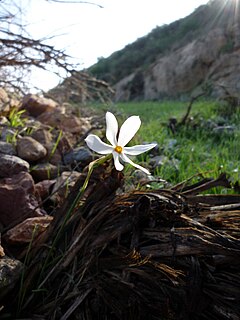
Narcissus serotinus is a species of the genus Narcissus (daffodils) in the family Amaryllidaceae. It is classified in Section Serotini. It is native to southern Europe from Portugal to Greece. It also native to Israel, where it blossoms in the autumn.

Narcissus viridiflorus, commonly known as campanitas, is a species of the genus Narcissus (daffodils) in the family Amaryllidaceae. It is classified in Section Jonquillae.

The taxonomy of Narcissus is complex, and still not fully resolved. Known to the ancients, the genus name appears in Graeco-Roman literature, although their interest was as much medicinal as botanical. It is unclear which species the ancients were familiar with. Although frequently mentioned in Mediaeval and Renaissance texts it was not formally described till the work of Linnaeus in 1753. By 1789 it had been grouped into a family (Narcissi) but shortly thereafter this was renamed Amaryllideae, from which comes the modern placement within Amaryllidaceae, although for a while it was considered part of Liliaceae.

Narcissus rupicola is a species of the genus Narcissus (daffodils) in the family Amaryllidaceae. It is classified in Section Jonquillae.
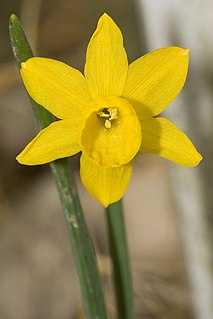
Narcissus calcicola is a species of narcissus (daffodils) in the family Amaryllidaceae. It is classified in Section Apodanthi. It is endemic to Portugal, though it is also thought to have scarce populations in southern Spain.
Narcissus nivalis is a species of the genus Narcissus (daffodils) in the family Amaryllidaceae. It is classified in Section Bulbocodium. It is native to Morocco in North Africa.

Narcissus lusitanicus is a species of the genus Narcissus (daffodils) in the family Amaryllidaceae. It is classified in Section Ganymedes. It is native to Portugal.
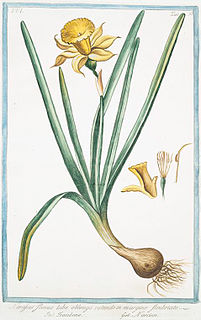
Narcissus blanchardii is a species of the genus Narcissus (daffodils) in the family Amaryllidaceae. It is classified in Section Jonquilla.
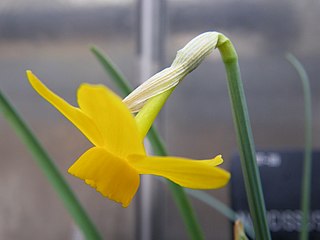
Narcissus cuatrecasasii is a species of the genus Narcissus (daffodils) in the family Amaryllidaceae. It is classified in Section Jonquilla. It is a native of the southern Iberian peninsula.
Narcissus bujei is a species of the genus Narcissus (daffodils) in the family Amaryllidaceae. It is classified in Section Nevadensis. The flower is a plain yellow. It is native to the Andalusia region of Spain, in particular the Comarca of Subbética (Córdoba) and the Sierra de las Nieves in the Serranía de Ronda (Málaga). It is considered an endangered species. Its preferred habitat is calcareous soils in small forests and irrigated land.
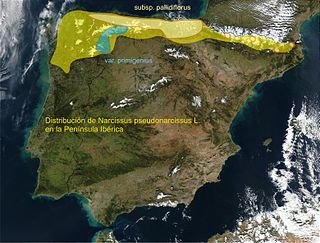
Narcissus primigenius is a species of the genus Narcissus (Daffodils) in the family Amaryllidaceae. It is classified in Section Pseudonarcissus. It is native to northwest Spain.
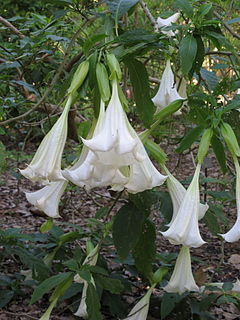
Angel's tears is a common name for several plants and may refer to:

Cliviinae is a small subtribe of Haemantheae, and therefore within the African clades of Amaryllidoideae. It consists of two genera, Clivia, and Cryptostephanus.














